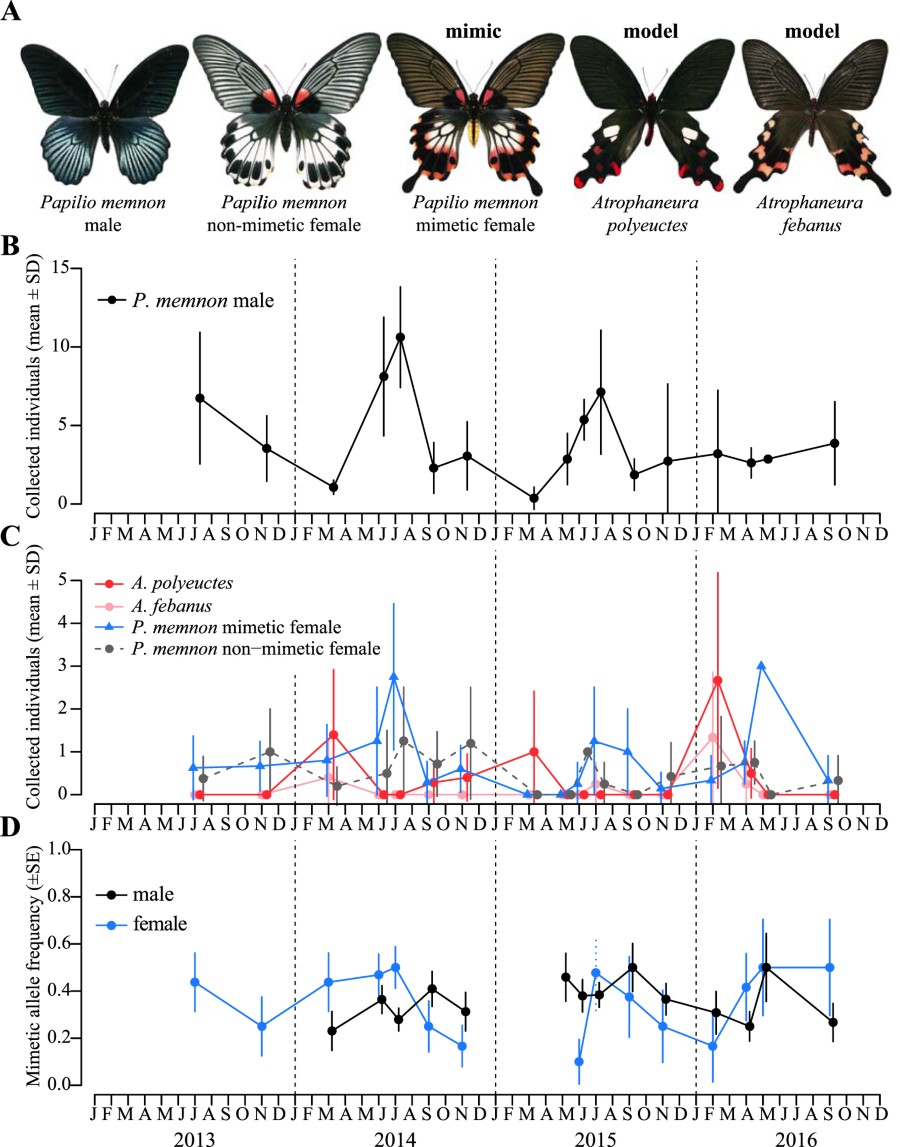調控大鳳蝶多態性與貝氏擬態性狀的超基因 "doublesex" 基因頻度的時序動態
 |
| 圖片來源:https://reefbuilders.com/2014/11/14/survival-reef-part-1-masquerading-false-colours/# |
標題:Temporal dynamics of the mimetic allele frequency at the doublesex locus, which controls polymorphic Batesian mimicry in Papilio memnon butterflies (open access)
摘要
Tracking allele frequencies is essential for understanding how polymorphisms of adaptive traits are maintained. In Papilio memnon butterflies, which exhibit a female-limited Batesian mimicry polymorphism (wing-pattern polymorphism), two alleles at the doublesex (dsx) locus correspond to mimetic and non-mimetic forms in females; males carry both dsx alleles but display only the non-mimetic form. This polymorphism is thought to be maintained by a negative frequency-dependent selection. By tracking dsx allele frequencies in both sexes at a Taiwanese site over four years, we found that the mimetic allele persists at intermediate frequencies even when the unpalatable model papilionid butterflies (Pachliopta and Atrophaneura species) were very rare or absent. The rates of male mate choice did not differ between the two female forms; neither did insemination number nor age composition, suggesting equivalent reproductive performance of the two forms over time. Our results characterised the temporal dynamics of the mimetic allele frequency in the field for the first time and give insights into underlying processes involved in the persistence of the female-limited Batesian mimicry polymorphism.
大鳳蝶是貝氏擬態的教科書經典案例,在亞洲對這個自家後院就看到的物種自不用說,而西方透過自華萊士時代的紀錄與研究,幾乎全世界都對這個例子的多態性、雌雄二態性與擬態間的關係與來源十分感興趣。這篇文章是京都大學的曾田貞滋教授 (Teiji Sota)及他的學生,與師大生科的林仲平教授合作,以台灣的大鳳蝶為材料,進行長達四年 (2013-2016) 的野外觀察與基因體研究的一部份成果。
這個研究的關鍵在於:首先,貝氏擬態的前提是以負向頻率(negative frequency-dependent selection)為選汰機制,意思也就是在已知的環境中,擬態者的數量不能過多,否則天敵遇到大部份的個體都能吃的話,這個擬態斑紋就可能失效。然而像斑紋高度多態性又牽涉雌雄二態的大鳳蝶,控制擬態的超基因 (supergene) 的族群基因頻率在環境中,如何在擬態與非擬態型中取得平衡就是個很有趣的問題了。
這個團隊執行了幾個部份的調查與實驗。(1) 他們在台灣花蓮以穿越線調查蝴蝶的狀況,並且分析其年齡、身體尺寸、天敵攻擊的咬痕,與交配的次數;(2) 分析大鳳蝶與其擬態模型紅紋鳳蝶 (Pachliopta aristolochiae)、大紅紋鳳蝶 (Atrophaneura polyeuctes) 與台灣麝香鳳蝶 (Atrophaneura febanus) 在這四年中的族群數量 (2) 設計行為的實驗測試大鳳蝶雄性對不同表型的雌性是否具有交配偏好;(3) 野外採集的個體帶回至實驗室進行分生的分析,將其基因型統計是否符合哈溫定律。主要的結果支持兩性的基因頻度的調查皆符合哈溫定律,而雄性無論對擬態或非擬態型的雌性都沒有特殊的擇偶偏好。在四年的觀察與採集中,doublesex的基因頻度維持在中等程度,並未因擬態模型的數量變動偵測到顯著變化,也未發現明顯的負向頻度選汰。也就是說,擬態模型在環境中的頻度與雄性無明顯擇偶偏好,都對doublesex的基因頻度沒有顯著的影響, 而這可能是大鳳蝶能夠維持斑紋多態性的原因。
===
以下是對這個研究的一些觀點:
- 這個研究的個體僅從花蓮取得,不知是否足以推及解釋台灣其他區域的族群。
- 一般來說,大鳳蝶的擬態對象認為是紅紋鳳蝶 (Pachliopta aristolochiae),而這個研究則認為不曾被紀錄是擬態對象的大紅紋鳳蝶 (Atrophaneura polyeuctes) 與台灣麝香鳳蝶 (Atrophaneura febanus) 也同時是其擬態模型。然而,紅紋鳳蝶與另兩種蝴蝶的棲地類型有所差異,根據這個研究的資料,在花蓮的研究地點紀錄的紅紋鳳蝶個體僅有1隻,遠低於大紅紋的21隻,有可能其觀測與採集地點並非天擇作用於擬態斑紋的主要活躍區域,因此擬態者的擬態模型與補食者的動物相的差異,可能影響基因頻率的觀察結果,而非單純的「維持在中等程度進而維持族群中翅紋的多態性」。若是未來能加入更廣泛區域的資料,能讓相關研究更加完整。
- 雖然大鳳蝶的擬態關係常被用來解釋擬態現象,但畢竟是以人類的視覺角度來觀察,而且大鳳蝶翅紋多態性的變化程度遠比想象中的高,如果一點點差異就會造成擬態效果的變化,那麼所謂「擬態型」的個體與其基因頻度或許要再評估。






0 comments